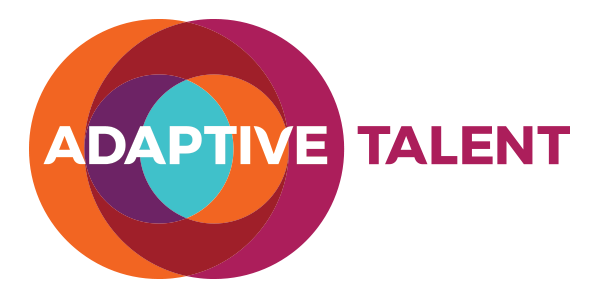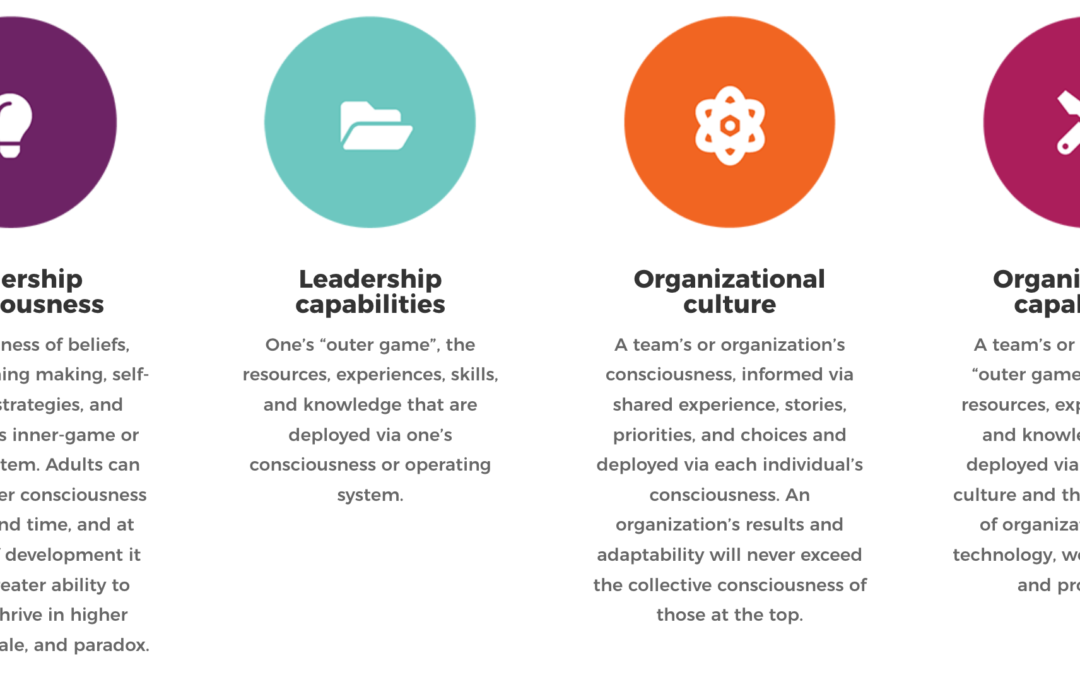I created this document as a personal intellectual and creative challenge to integrate everything I’ve been learning from business strategy, agile/lean practices, neuroscience, coaching, systems thinking, and organizational development into a strategic and pragmatic organizational framework and process.
A main deliverable with executive coaching is helping clients generate greater clarity and capability. Execs are busy, so often taking a strategic time out to reflect how they want to evolve their organization is tough because they’re tired, overwhelmed, and need to deal with the more tangible “stuff” that needs to get done. However, clarity and capability for them only goes so far if they can’t do that at an organizational level. I began looking for a simple model that any exec team could use to address the key elements of both its culture and desired capability, and ideally how employees could map their own purpose, values, gifts, etc. to those of the organization for a great pairing.
A key moment came when I watched Simon Sinek’s TED talk on “Start with Why” and saw his Golden Circle model. If you’ve not seen the video, I highly recommend it. His model looks like a bull’s-eye, with Why at the center, the How layer next, and the What layer after. I immediately loved that his model had layers of meaning that informed how the elements in the subsequent layers should work individually, and collectively. It reminded me of design thinking principles.
This is a long document, so I’ve broken it into multiple sections. It’s written not just for HR people or senior execs, but anyone who senses that big changes must occur in how we envision and manage organizations. Like me, this document is a work in progress that has its strengths and deficiencies. It’s also limited by what I have come across, so I enthusiastically welcome people’s input and ideas to strengthen its utility. I’d love to see this become a tool shared and improved by people across the world.
I have some core beliefs that shape this document:
(1) In today’s world disruption is easier to achieve and success is more difficult to maintain. A study from the John M. Olin School of Business at Washington University estimates that 40 percent of today’s S&P 500 will no longer exist in 10 years. According to Dr. Peter Diamandis “These are exponential technologies—artificial intelligence, robotics, infinite computing, ubiquitous broadband networks, digital manufacturing, nanomaterials and synthetic biology—that will enable us to make greater gains in the next two decades than we have in the past 200. They will have transformational impact hard for us to imagine today.” Our world is on-demand, non-linear, faster, interconnected, and more competitive than ever before and these factors are accelerating. Throw away the old playbooks; as Jennifer Garvey Berger said “Moving from ‘managing the probable’ to ‘managing the possible’ requires us to address challenges in a fundamentally different way.”[1]
(2) A leader’s level of consciousness – her/his reality about how the world works and what’s possible, and his/her awareness of self, others, and their environment – impacts how s/he approaches everything especially leadership, power, control, and relationships and is literally a cap on organizational results. This is true for individuals, teams, and organizations. In predictable environments most leaders can get by simply by following process or adopting best practices. However many businesses now regularly operate in volatile, uncertain, complex, and ambiguous (VUCA) environments where leaders face adaptive challenges that demand innovation and learning because the problems are complex, solutions unknown, and require systems level solutions from all participants. Many leaders don’t understand the difference and simply adopt traditional practices and never question how their thinking and worldview creates limits on awareness (Kodak or BlackBerry are great examples).
Frederic Laloux, author of the book Reinventing Organizations (one of the most inspiring and interesting books I’ve read recently) and thisarticle does a wonderful job of explaining humankind’s evolution, where we’re headed, and why we must be intentional in designing our organizations and developing our leaders for maximum adaptability. When we are unaware of our own filters, bias, and thinking, or when we unconsciously adapt ways of working and thinking without evaluation, we set ourselves up for failure.
(3) We are experiencing a golden era of neuroscience and organizational thinking that inspire us to relate and work in mind-friendly ways, and to look at organizations with fresh eyes. Because we now understand our biology better we realize that our mind, or our consciousness, is not entirely constructed within our brain. Interpersonal Neurobiologist Dr. Daniel Siegel defines the mind as an embodied and relational, emergent, self-organizing process that regulates energy and information flow. Note I said mind, not brain: Scientists estimate we have three neurological networks or “brains”: in our head with 85b neurons, around our heart with 40m neurons, and in our gut with 60m neurons. Collectively these centres of awareness or intelligence, and our interactions with others, contribute to our consciousness.
Importantly, note the part about the mind being relational. We unconsciously and automatically adopt and influence each other’s perceptions, fears, hopes, and conceptions of reality in profound ways. Could the definition of the mind apply to an organization’s culture? Culture is embodied when you “just know” what’s valued and it influences your actions. Organizational systems, structures, and funded priorities are a form of shared embodiment. It’s emergent because it’s dynamic and happening only in the present moment, building on the past to influence the future. It’s self-organizing because no one person or entity can control it, and of course culture impacts energy (emotion) and information flow both individually and collectively.
There’s also very interesting new thinking about change management in complexity, and essentially questioning the traditional view that change is a discrete event capable of being managed through a rational process. What if the very structure and mindset you hold as an organization might actually limit or preclude you from seeing what’s happening, or emerging? This is where insights into human consciousness, our brain’s resistance to change, insights into creativity, and complexity theory all merge in fascinating ways and begin to make me wonder if maybe those principles around self-managing organizations aren’t so crazy after all.
(4) Structurally, I am convinced we have entered a transformative era for organizational design and development necessitated by generational expectations and exponential technology. Our old/current ways of working are being pushed aside by a more expansive, inclusive, experimental, and purpose driven approach to leveraging the amazing abundance of knowledge provided by data-rich, algorithm-driven, machine learning systems. We will see smaller core teams, complemented by specialized, on-demand, talent (often self-organizing), that enables today’s tighter cycles and customer expectations. We also have the most diverse workforce of any era with 20-somethings often working alongside 60+ year olds, and a vibrant mix of cultures, crafts, orientations, etc. Organizations are opening up and being more transparent because they can tap into wisdom and resources like never before (and to not do so places them at a competitive disadvantage). Social networking demands authenticity, transparency, and interaction unheard of in prior eras. Organizations that use these platforms for insight and intimacy can gain an incredible advantage.
(5) Finally, I believe that people want and deserve more out of work and their organizations. Our world needs better collaboration between governments, NGOs, and for-profit corporations beyond the economy and including all aspects of society. People want to contribute, to be themselves, to grow, to feel safe, to create, and to belong to something bigger than themselves. This last point may in fact be the single most important source of creativity, learning, and execution in a VUCA environment. Younger generations are self-selecting into organizations that are values-led, eager to experiment, and aligned with their generation’s expectations.
The Core Idea
If you accept the premise that a core business result in today’s world must be organizational adaptability, then the role of people strategy shifts from one that supports the business strategy to one that is itself a primary element of the business strategy: creating a culture and shared ability to sense, learn, and create faster than the competition. The question is how to construct an intentional approach to something that seems so subjective and dynamic.
Here’s a starting point: Adaptability = Execution * Experimentation
Adaptability happens when there’s a dynamic, long-term, energy-generating interplay between two organizational meta-capabilities: getting stuff done and the simultaneous ability to experiment and enhance. This is true for individuals and organizations and absolutely requires investment and alignment across Ken Wilber’s famous four quadrants. Bob Anderson, Founder of The Leadership Circle, addresses each of four quadrants of change:
“Quadrant 1 is the individual/internal aspect of change. This is the interior reality of people. It is the area of cognitive, psychological, and spiritual development. In this quadrant leaders attend to the inner development of people, recognizing that no substantive change is possible without a prior change in consciousness.
Quadrant 2 has to do with the individual/external aspects of change. This is the domain of technical and interpersonal skills as well as the science (physiology/neurology/ psychology) of peak performance. This quadrant gets a great deal of attention from coaches and world-class athletes. It is where leaders pay attention to developing peoples’ skills and supporting the physical and psychological ingredients that spark motivation and peak performance.
Quadrant 3 deals with the collective/ internal aspects of change. This is the domain of culture. It is the interior, often hidden, territory of our shared assumptions and images that direct what happens when we come together. This is the domain of myth, story, unwritten rules, and beliefs. It reminds leaders to pay attention to the deeper meanings of symbols, purpose, vision and values-not so much as written, framed, statements, but, as the subtle messages encoded in our day-to-day interactions.
Quadrant 4 has to do with the collective/external aspects of change, the social/ technical/ organization system. It is the quadrant of organizational design, technology workflow, policies, and procedures. This quadrant reminds leaders that system design determines performance and that if we want to get the system to perform at a substantively higher level, we must design for it.”
You can think of quadrants 1 and 3 as the inner game, the operating system of the individual and organization. Execution and experimentation happen obviously at the individual and collective level and the probability of making progress is dramatically enhanced when all four quadrants are addressed and aligned in service of an energizing vision. It’s been my experience that most leaders focus on the external quadrants (2 and 4) and struggle with the inner. If I’ve learned one key thing since being a coach, it’s that the inner game always drives the outer game.
Next up: Adaptability Blockers: Or…welcome to your Frankenstein organization
—
Adaptive Talent is a talent consultancy designed to help organizations achieve amazing results and ongoing adaptability. Founded in 2008 and based in Vancouver, Canada we offer retained search, assessments, total rewards consulting, training, leadership coaching and development programs, and culture & organizational development consulting.

